How to grow lemons and other citrus
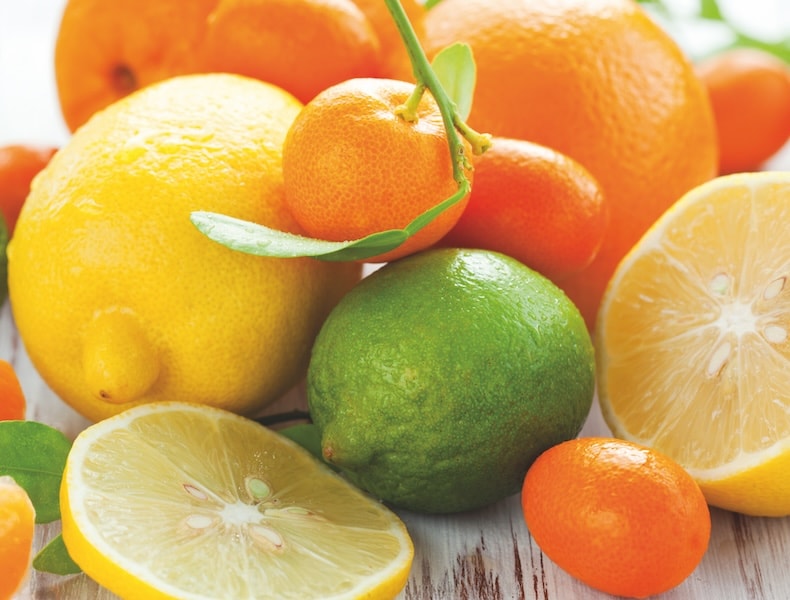
Citrus trees add colour and interest to your garden
Image: Patio Citrus Kit - Gift from Thompson & Morgan
For hundreds of years, Citrus trees have been status symbols, showing off the skills of the proud gardeners who grew them and the wealth of those who built elaborate orangeries to house them.
But don't let this intimidate you! In mild gardens, it's perfectly possible to grow Citrus in containers. Treat them like other tender shrubs – grow them in a warm, sheltered spot outdoors and overwinter them in a greenhouse or conservatory.
Whether you want to try growing lemons, limes, oranges or exotic kumquats, here are some top tips for growing citrus trees in the UK:
- Why grow Citrus?
- How to look after your Citrus trees
- What temperature do Citrus trees need?
- What type of soil should I plant my Citrus trees into?
- Where should I put my Citrus trees in the summer?
- How do I get my Citrus tree to fruit?
- How do you water Citrus trees?
- How do I feed my Citrus tree?
- How do you prune a Citrus tree?
- How do I look after my Citrus tree over winter?
- How do I keep my Citrus tree free of pests and disease?
- Best Citrus trees to choose for beginners
- Best Citrus trees to choose for experienced growers
Why grow Citrus?
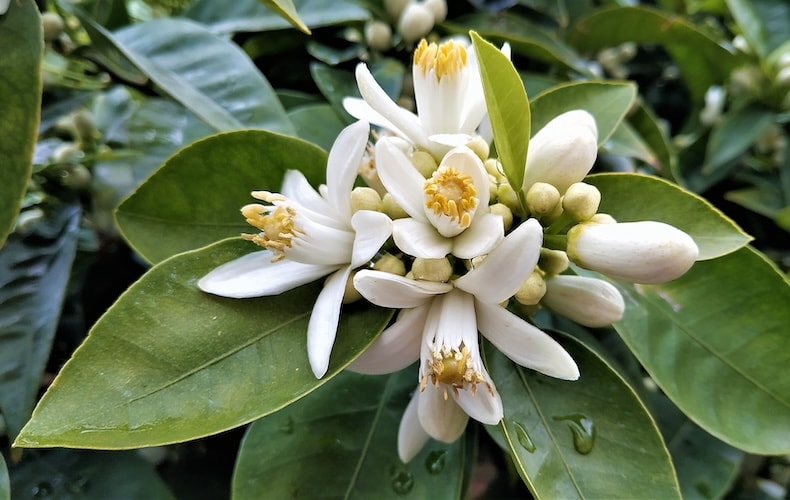
Flowering is not seasonal - fragrant blooms appear whenever conditions are suitable
Image: Bitter Orange tree from Thompson & Morgan
There are many reasons to grow your own Citrus trees, including:
- Scented Flowers: The heady perfume of Citrus flowers is unmistakable. Citrus flowering is not dependent on season but is initiated by warm temperatures and regular rainfall. Consequently, flowers are produced over a long period, sometimes appearing at the same time as fruiting. Their sweet fragrance is a real treat when you're relaxing on the patio.
- Habit: Citrus are slow growing, naturally forming well-shaped, bushy plants that look superb in containers. They are the perfect proportions for smaller courtyard gardens and terraces.
- Foliage: Aside from Citrus trifoliata, all the Citrus are evergreen with glossy, bright green leaves that look handsome all year. The foliage is also highly aromatic and has numerous culinary and cosmetic uses. Leaves can be used to infuse teas or wrapped around meats. In the case of Kaffir lime leaves, they are an essential ingredient of Asian cuisine.
- Fruits: Citrus fruits both look and taste fabulous. Growing your own provides the opportunity to taste some of the rarer varieties, and try them out in preserves, candied peels, liqueurs and drinks plus Asian cookery.
How to look after your Citrus trees
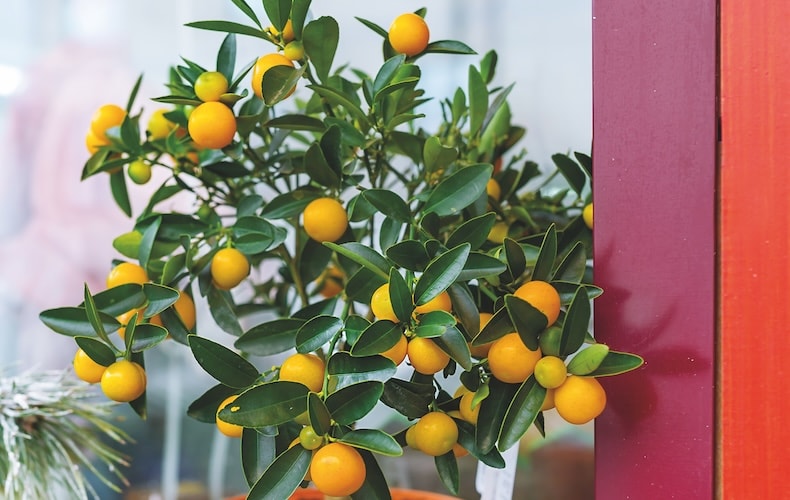
This orange bush is perfect for a warm conservatory
Image: Orange fruiting bush from Thompson & Morgan
What temperature do Citrus trees need?
Citrus are tropical shrubs and they will not survive frost. Optimal temperatures for growth are 15 -30C (58-86F) whilst minimal night time temperatures over the winter vary depending on the variety of Citrus, with some being hardier than others. Most Citrus need to be kept at least above 5C and prolonged cold temperatures below this will negatively affect vigour and fruit production.
With the exception of Citrus trifoliata, which is hardy down to -20°C, and possibly the Yuzu, which may survive temperatures down to down to -5C, Citrus are best grown in containers, overwintered in a greenhouse or conservatory, and then placed outside for the summer months.
Above 35°C (96°F) Citrus stop growing and so adequate greenhouse ventilation is required in spring to prevent temperatures from getting too high. When all danger of frost has passed in around late May, plants can be moved outside.
What type of soil should I plant my Citrus trees into?
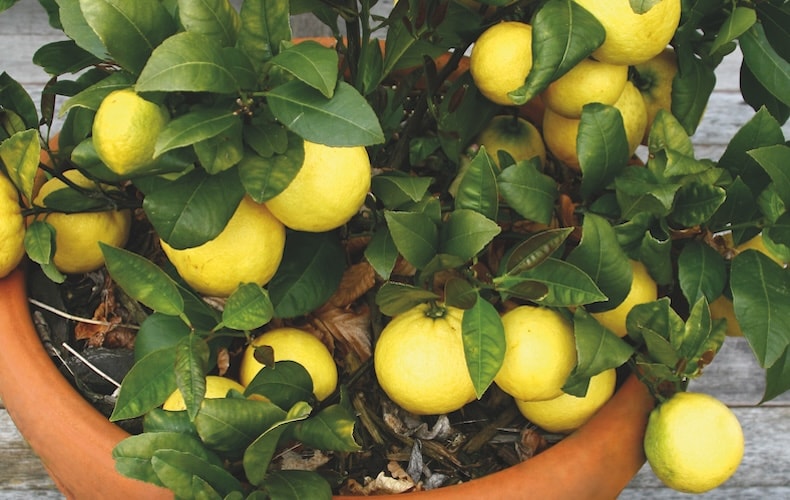
Terracotta pots are a good choice for patio citrus trees
Image: Mediterranean Fruit Collection from Thompson & Morgan
In spring, plant your Citrus into a large container at least 60cm in diameter. Citrus enjoy fertile, well-drained, slightly acid soil with a pH of 6-6.5. We recommend a 50/50 mix of John Innes No 3 and a soil-less compost.
Terracotta pots are advisable as they offer the best drainage. Line the bottom of the pot with plenty of broken crocks. Repot every 2-3 years in spring or summer before the plant becomes root-bound.
Where should I put my Citrus trees in the summer?
Once all risk of frost has passed at the end of May/mid June, move plants out from their winter housing into a shady spot, then gradually expose them to full sun over the course of a week. Keep an eye on local weather forecasts and be aware of sudden cold nights. If necessary, protect plants with fleece overnight. Place them into a south or west-facing position, preferably with the shelter of a wall and with good windbreaks.
How do I get my Citrus tree to fruit?
All Citrus are self-fertile and so do not require a pollination partner. Flowering is not seasonal but takes place throughout the year, with flowers and fruit often appearing at the same time.
To stop flowers dropping and to ensure good fruit set, maintain regular watering. If young fruits become soft, this may be an indication that your Citrus tree requires watering as it will draw water from the fruit when the soil is too dry.
To avoid stressing the plant and encourage a good quality crop, thin the young fruits, leaving about 20 on a 1m tall tree. Fruits ripen very slowly and it can take 6 to 12 months from fruit set to ripening. The fruits can be left on the tree until needed or harvested by cutting the fruit stalk with secateurs. They may be stored for several weeks in a cool place at 4-6C.
How do you water Citrus trees?
During the growing season, use a 'drench between drought' routine. Water frequently in dry summer weather – on average once a week - particularly when flowers and fruit are forming. Soak the compost thoroughly, watering from the top, then allow the plant to almost completely dry out.
Use the same technique in winter but water less frequently. Avoid over-watering at all costs, and never allow the plant to stand in water. Rest your containers on 'feet' and stand them in trays filled with clay pebbles. This will also provide the extra humidity that Citrus trees enjoy.
How do I feed my Citrus tree?
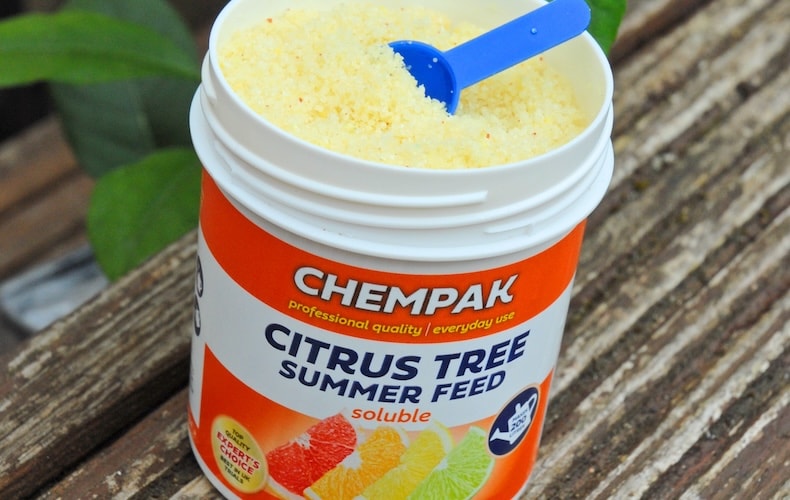
Use a specialist citrus tree feed to keep your plants healthy
Image: Chempak citrus tree feed (soluble) from Thompson & Morgan
Citrus are greedy plants and close attention should be paid to feeding to ensure good fruit set and overall plant health. From late March to October, they should be fed weekly with a specialised high nitrogen liquid summer feed at the same time as watering. When watering is less intense in winter and early spring, maintain a feeding regime by spraying a winter liquid fertiliser onto the leaves as a 'foliar feed'.
How do you prune a Citrus tree?
Citrus require minimal pruning, simply encourage bushy growth by pinching back the ends of vigorous shoots during the summer. Remove any sprouts from below the graft union whilst they are still young and prune back any vertical 'water shoots' so they don't take over and unbalance the symmetry of the tree.
Lightly prune In February, removing crossing, dead, diseased, weak or misplaced growth to maintain air flow and light into the centre of the crown.
If necessary, mature specimens that have become leggy can be treated to harder pruning in early spring. Plants will readily regenerate from old wood and will normally flower in the same year on the current season's growth.
How do I look after my Citrus tree over winter?
Move plants into a frost free environment giving them as much light as possible. Small plants can be placed on a sunny, south-facing windowsill but larger plants will require a conservatory or greenhouse. Keep them away from draughts and radiators and avoid sudden fluctuations in temperature, ensuring that the glasshouse/conservatory is well ventilated.
How do I keep my Citrus tree free of pests and disease?
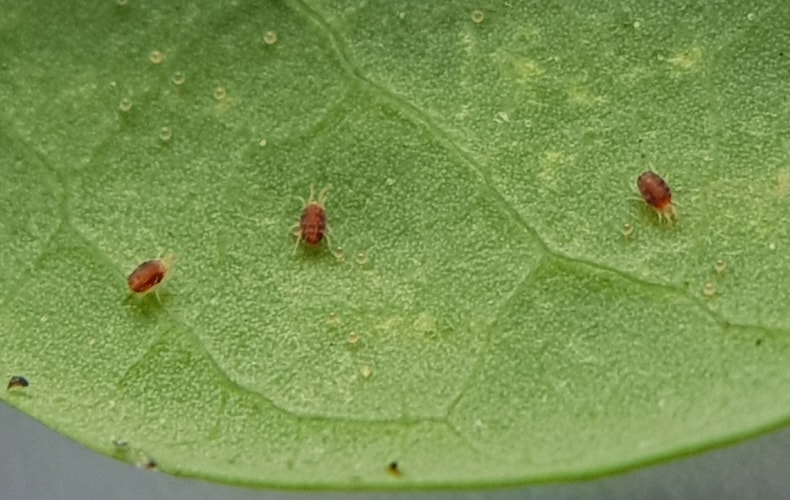
Close up of red spider mite (two-spotted spider mite) on a Citrus leaf
Image: Dreamstime
Citrus trees are vulnerable to red spider mite, scale insect, mealy bugs and aphids. Don't wait for the pests to arrive! The following operations should form a normal part of your routine Citrus care:
- Regular spraying with a non-toxic, surfactant pesticide such as SB Plant Invigorator
- Good temperature control of your greenhouse/conservatory through adequate ventilation
- Thorough greenhouse cleaning
- Increasing humidity in the greenhouse by damping down the floor with water and syringing plants
- Introduction of biological controls during the overwintering period
Red spider mite is a sap-sucking insect that causes a characteristic very fine stippling on the upper leaf surface. These tiny little mites will literally suck the life out of your plants!
Somewhat confusingly, Red Spider Mite is rarely red, but a dirty yellow/brown colour with two dark patches on its back. Turn leaves over and you will just make out the tiny mites, egg shells and cast skins. The mites reproduce extremely rapidly, and in warm greenhouses can continue to do so throughout the winter. If infestations are severe, plants become covered in webbing. At this point, it is impossible to regain control of the situation!
Red Spider Mite is highly resistant to pesticides but effective biological controls are available on the internet. The aim of these controls is not to eliminate the pest entirely, but to keep populations as low as possible so that plants are not damaged. Using biological controls is not difficult but timing is critical – follow the supplier's instructions to the letter. All the routine cultural measures listed above will also help to control this pest.
Scale insects look like tiny yellowish/brown scales beneath the leaves. Mealy bugs appear as a fluffy white wax hidden in leaf axils and other crevices. Both are sap-sucking insects that excrete a sticky substance which encourages the growth of sooty moulds. Populations of these pests rarely become damaging - regular treatment with a surfactant-based spray will keep them under control.
Best Citrus trees to choose for beginners

1. Citrus 'Orange Flying Tiger'
If you want the sight and scent of Citrus but don't have the indulgence of a greenhouse or conservatory, then Citrus 'Orange Flying Tiger' (Citrus trifoliata) is the perfect answer. Hardy down to -20°C, this tough, deciduous shrub is rarely seen in gardens, despite being tolerant of drought and shallow, chalky soils.
Its twisting armature of flattened, spiky stems remains green all year and creates a striking winter silhouette. The trifoliate leaf pattern and winged stems are also distinctive features, and unlike its evergreen relatives, Citrus trifoliata offers autumn interest when the foliage turns yellow before falling.
In March/April, it's covered in orange-scented white flowers that are followed by knobbly, yellow-green fruits. The small, downy fruits are held on contorted branches throughout winter, injecting much needed colour into the winter landscape. Although they are too bitter and pithy for using fresh, the zest adds an intense citrus punch to cakes, marmalades and cocktail garnishes.

2. Citrus Yuzu
The juice of a Yuzu Citrus plant is an expensive and gourmet ingredient that is almost impossible to find outside of Japan. Fortunately, it's a good Citrus plant to grow as a beginner. A hybrid between a mandarin and the wild Ichang papeda – a mountain dweller that is one of the hardiest of Citrus - the Yuzu has inherited the frost hardiness of its ancient Ichang parent and is said to tolerate temperatures as low as −5 °C. Hardiness is always an inexact science but some gardeners may be brave enough to experiment with leaving their Yuzu outside all winter if it's in a well-sheltered position. During hard frosts, bubble wrap or fleece are advisable to prevent tip die-back.
The Yuzu bears the distinctive foliage and thorny stems of its Ichang parentage which is shared with the Kaffir lime. Each leaf is held on a large leaf-like stalk, giving the unusual appearance of a double leaf. The intensely aromatic fruits resemble small oranges with bumpy skin.
With its unique combination of sweet mandarin and tangy grapefruit flavours, Yuzu juice has become popular amongst celebrity chefs. Widely used in East Asian cooking, it's an essential ingredient for Japanese Ponzu Sauce – a flavour-packed dipping sauce for all manner of noodles, salads, dumplings, grilled meats and fish. Yuzu can be used just like lemons or limes, but is enhanced with a sweet orange perfume and sherberty zing. Give it a whirl in cakes, cocktails and preserves for a citrus flavour with a difference.
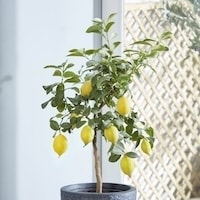
3. Lemon 'Eureka'
Another good choice for newbie citrus growers, patio lemon trees are hardier than other Citrus and can survive short periods of temperatures below 5°C. However, as with all Citrus trees, they require good winter protection under glass.
Flowering over a long period, lemons provide interest throughout the season, with fruits and flowers often appearing simultaneously. With good care, trees will have fruit in various stages of maturity – from small nascent fruits to mature lemons that can be harvested or 'stored' on the tree for later use. With this extended harvest of fruit and long-lasting ornamental display, you can lap up plenty of Mediterranean style whilst supping your lemon G&T on a sunbaked patio!
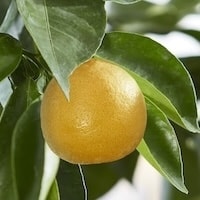
4. Bitter orange
If oranges are more to your taste, the Bitter Orange or Seville Orange is the easiest variety to grow in the UK. Introduced into Spain by the Moors, it is emblematic of Seville, with the southern Spanish city boasting over 40,000 specimens! Its use as an urban tree is a testament to both its vigour and its ornamental value. In spring, the streets of Seville are soaked with the scent of orange blossom, in summer the lush leaves offer greenery and shade, whilst in autumn-winter it is valued as a 'Christmas Tree' due to its decorative golden fruits.
Often used as a rootstock, the Bitter Orange is a strong hybrid with greater cold tolerance than other Citrus. Although unsuited for raw consumption or juicing, the thick peel, bitter pulp and a very high pectin content make the Seville Orange perfect for marmalade. The strongly aromatic leaves are also valued for their essential oils and are used in aromatherapy, cosmetics and flavouring drinks.
Best Citrus trees to choose for experienced growers

1. Citrus Kumquat
Kumquats are renowned for being generous fruiters, bearing masses of olive-sized, orange-like fruits that makes them one of the most ornamental Citrus trees. The peel is surprisingly sweet whilst the flesh is sour, resulting in a unique flavour profile that succeeds in both sweet and savoury dishes. All parts of the kumquat can be eaten raw or cooked, and this versatile fruit can be enjoyed in marinades, pickles, candied peels, fruit salads and cocktails.
Kumquats are much hardier than sweet oranges and limes but they require plenty of heat to flower. They need to be kept in a glasshouse or conservatory all summer for them to bloom adequately in late July/early August. Crossed with a lime, the kumquat becomes a Limequat resulting in a Citrus that is hardier than other limes but not quite as hardy as its Kumquat parent.
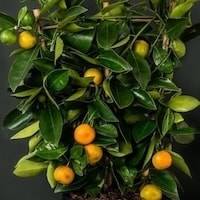
2. Calamondin Orange
Cross the kumquat with a mandarin and the result is the very pretty Calamondin Orange (Citrus madurensis). Bearing gorgeously-scented flowers almost non-stop, the Calamondin often displays heavy crops of small fruits for more than six months. Its dwarf proportions even make it suitable for growing as a houseplant.
Bursting with an intense lemon-orange flavour, the sour fruits are great for marmalade, drinks and marinades.
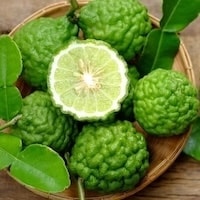
3. Kaffir or Makrut Lime
As well as the familiar Tahiti or Green lime that you see in the shops, experienced growers might fancy the more unusual Kaffir or Makrut Lime with its distinctive knobbly fruits and double-leaf pattern. The leaves of the Kaffir lime are highly aromatic, and an essential ingredient in Thai curries. Another option, the Rangpur Lime, is a lemon x mandarin hybrid that produces orange fruits with a sour lemon flavour and aromatic leaves that are great in curries.
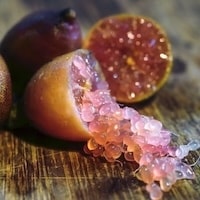
4. Lime 'Caviar Lime'
Crossing to another continent, The 'Australian Finger Lime' or 'Caviar Lime' is a completely different beast to all other Citrus, producing dark, slender fruits on spiny, small-leaved trees. The 'Citrus pearls' inside these gourmet fruits explode like sherbert when chewed!
Appreciating warm temperatures, these limes require a large greenhouse or conservatory for overwintering. Once all danger of frost has passed, they can be placed outside for the summer months.
We hope you find this guide helpful. Find more practical tips in our Lemons Masterclass or browse our fruit trees hub page for a wealth of information about growing full-sized and patio fruit trees.








